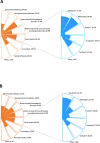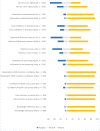A survey of patient and public perceptions and awareness of SARS-CoV-2-related risks among participants in India and South Africa
- PMID: 37428718
- PMCID: PMC10332587
- DOI: 10.1371/journal.pgph.0001078
A survey of patient and public perceptions and awareness of SARS-CoV-2-related risks among participants in India and South Africa
Abstract
A cross-sectional survey among participants in India and South Africa to explore perceptions and awareness of SARS-CoV-2-related risks. Main outcome measures-proportion of participants aware of SARS-CoV-2, and their perception of infection risks as it related to their views and perceptions on vaccination, i.e., using COVID-19 vaccine uptake as proxy for awareness level. Self-administered questionnaires were used to collect data via web- and paper-based surveys over three months. Pearson's Chi-squared test assessed relationships between variables; a p-value less than 0.05 was considered significant. There were 844 respondents (India: n = 660, South Africa: n = 184; response rate 87.6%), with a 61.1% vs 38.3% female to male ratio. Post-high-school or university education was the lowest qualification reported by most respondents in India (77.3%) and South Africa (79.3%). Sources of pandemic information were usually media and journal publications (73.2%), social media (64.6%), family and friends (47.7%) and government websites (46.2%). Most respondents correctly identified infection prevention measures (such as physical distancing, mask use), with 90.0% reporting improved hand hygiene practices since the pandemic. Hesitancy or refusal to accept the SARS-CoV-2 vaccine was reported among 17.9% and 50.9% of respondents in India and South Africa, respectively; reasons cited included rushed vaccine development and the futility of vaccines for what respondents considered a self-limiting flu-like illness. In South Africa, vaccine acceptance was associated with improved hand hygiene practices since the pandemic and flu vaccination in the preceding year. No relationship was noted between awareness and practice of infection prevention measures (such as hand hygiene) and socio-demographic factors such as employment status or availability of amenities. Pandemic response and infection prevention and control measures through vaccination campaigns should consider robust public engagement and contextually-fit communication strategies with multimodal, participatory online and offline initiatives to address public concerns, specifically towards vaccines developed for this pandemic and general vaccine hesitancy.
Copyright: © 2023 Mbamalu et al. This is an open access article distributed under the terms of the Creative Commons Attribution License, which permits unrestricted use, distribution, and reproduction in any medium, provided the original author and source are credited.
Conflict of interest statement
The authors have declared that no competing interests exist.
Figures


Similar articles
-
The effect of framing and communicating COVID-19 vaccine side-effect risks on vaccine intentions for adults in the UK and the USA: A structured summary of a study protocol for a randomized controlled trial.Trials. 2021 Sep 6;22(1):592. doi: 10.1186/s13063-021-05484-2. Trials. 2021. PMID: 34488843 Free PMC article.
-
Longitudinal changes in COVID-19 vaccination intent among South African adults: evidence from the NIDS-CRAM panel survey, February to May 2021.BMC Public Health. 2022 Mar 2;22(1):422. doi: 10.1186/s12889-022-12826-5. BMC Public Health. 2022. PMID: 35236319 Free PMC article.
-
Direct and Indirect Associations of Media Use With COVID-19 Vaccine Hesitancy in South Korea: Cross-sectional Web-Based Survey.J Med Internet Res. 2022 Jan 6;24(1):e32329. doi: 10.2196/32329. J Med Internet Res. 2022. PMID: 34870605 Free PMC article.
-
SARS-CoV-2 variants and the global pandemic challenged by vaccine uptake during the emergence of the Delta variant: A national survey seeking vaccine hesitancy causes.J Infect Public Health. 2022 Jul;15(7):773-780. doi: 10.1016/j.jiph.2022.06.007. Epub 2022 Jun 17. J Infect Public Health. 2022. PMID: 35728424 Free PMC article.
-
COVID-19 vaccine hesitancy in South Africa: how can we maximize uptake of COVID-19 vaccines?Expert Rev Vaccines. 2021 Aug;20(8):921-933. doi: 10.1080/14760584.2021.1949291. Epub 2021 Jul 12. Expert Rev Vaccines. 2021. PMID: 34252336 Review.
Cited by
-
Mentorship as an overlooked dimension of research capacity strengthening: how to embed value-driven practices in global health.BMJ Glob Health. 2024 Jan 4;9(1):e014394. doi: 10.1136/bmjgh-2023-014394. BMJ Glob Health. 2024. PMID: 38176742 Free PMC article.
-
Power Relations in Optimisation of Therapies and Equity in Access to Antibiotics (PROTEA) Study: investigating the intersection of socio-economic and cultural drivers on antimicrobial resistance (AMR) and its influence on healthcare access and health-providing behaviours in India and South Africa.Wellcome Open Res. 2024 Jul 24;9:400. doi: 10.12688/wellcomeopenres.20193.1. eCollection 2024. Wellcome Open Res. 2024. PMID: 39315357 Free PMC article.
References
-
- World Health Organization. COVID‑ 19 Strategy Up Date. 2020. Available from: https://www.who.int/docs/default-source/coronaviruse/covid-strategy-upda... (accessed 17 August 2020).
-
- Woke FI. Communicating COVID-19 prevention health messages: a case study of South Africa. WebMedCentral Epidemiology. 2020:11(9): WMC005633.. Available from: https://www.webmedcentral.com/wmcpdf/Article_WMC005633.pdf (accessed 8 August 2021).
-
- Abdullahi L, Onyango JJ, Mukiira C, Wamicwe J, Githiomi R, Kariuki D, et al.. Community interventions in low—and middle-income countries to inform COVID-19 control implementation decisions in Kenya: a rapid systematic review. PloS ONE. 2020;15(12 December):1–29. doi: 10.1371/journal.pone.0242403 - DOI - PMC - PubMed
LinkOut - more resources
Full Text Sources
Miscellaneous
